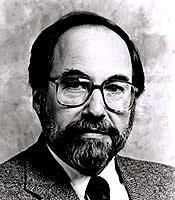David Baltimore, Ph.D.

Brief Bio
David Baltimore was born in New York City on March 7, 1938, Baltimore decided on a career in biological research while spending a high-school summer at the Jackson Laboratory in Bar Harbor, Maine. After earning his B.A. in chemistry with high honors from Swarthmore College in 1960, he studied biophysics at the Massachusetts Institute of Technology (MIT) for one year before transferring to the Rockefeller Institute to study animal virology under Richard Franklin. He received his Ph.D. at the Rockefeller Institute in 1964 and remained there as a postdoctoral fellow in James E. Darnell's (AAI '60) laboratory. The following year, he accepted a position as a research associate at the Salk Institute, where he began his work with Dulbecco. Baltimore became an associate professor of microbiology at MIT in 1968 and rose to full professor in 1972. He served as the founding director of the Whitehead Institute of Biomedical Research, an independent research center affiliated with MIT, from 1982 to 1990, when he was appointed president of the Rockefeller University.
Baltimore remained at Rockefeller University until 1994, when he returned to MIT as Ivan R. Cottrell Professor of Microbiology and Immunology. In 1997, he was named president of Caltech and served in that post until 2006, when he became president emeritus and Robert Andrews Millikan Professor of Biology. He served as chair of the National Institutes of Health AIDS Vaccine Advisory Committee from 1996 to 2002.
Nobel Prize in Physiology or Medicine
1975 Nobel Prize in Physiology or Medicine with Renato Dulbecco and Howard Temin “for their discoveries concerning the interaction of tumor viruses and the genetic material of the cell.”
Lasker Award
2021 Lasker~Koshland Special Achievement Award in Medical Science. “As one of the premier biomedical scientists of the last five decades, he is renowned for the breadth and beauty of his discoveries in virology, immunology, and cancer; for his academic leadership; for his mentorship of prominent scientists; and for his influence as a public advocate for science.”
Click here for more details.
AAI Service History
Joined: 1984
Nobel Prize in Science
David Baltimore, California Institute of Technology (Caltech), was awarded the 1975 Nobel Prize for Physiology or Medicine jointly with Renato Dulbecco and Howard Temin for "their discoveries concerning the interaction of tumor viruses and the genetic material of the cell."
Baltimore and Temin independently discovered reverse transcriptase, the enzyme that transcribes ribonucleic acid (RNA) to deoxyribonucleic acid (DNA), publishing their results in the same issue of Nature in 1970. Until this work, the central dogma of molecular biology held that the transfer of sequential information could pass only from DNA to RNA to protein. Both Baltimore and Temin, having worked in Dulbecco's laboratory earlier in their careers, were building upon his discovery in the 1950s that RNA viruses could alter an infected host's DNA.
The discovery of reverse transcriptase "marked not only a new chapter in cancer research but also had more general and far reaching biological consequences," declared Peter Reichard of the Karolinska Institute at the Nobel presentation ceremony. The discovery's full significance to medical science became much more evident several years later, when knowledge of the functioning of reverse transcriptase proved crucial to understanding retroviruses, most notably human immunodeficiency virus (HIV).
By the mid-1970s, Baltimore had turned his attention from virology to molecular immunology and DNA technology. In 1986, his laboratory discovered the transcription factor NK-κΒ, initially thought to be expressed only in B cells, but subsequently shown to be a member of a family of widely expressed regulators of transcription. He considers his laboratory's most significant contribution in the field of immunology to be the discovery of recombination activating genes (RAG). The enzymes encoded by these genes (RAG-1 and -2) are responsible for initiating the recombination of the V, D, and J genes of immunoglobulins and T cell receptors. His work on synthetic vaccines includes his demonstration that a synthetic peptide induces development of effective antibodies against polio in rats. More recently, he has devoted considerable attention to engineering a viral vector that might be used in HIV therapy and ultimately as an HIV vaccine. He has also pioneered work on the role that microRNAs—RNA molecules that regulate gene expression through repression of translation or targeted degradation of mRNAs—play in the inflammation response.
Awards and Honors
- Gustav Stern Award in Virology, 1970
- Eli Lilly and Company Award in Microbiology and Immunology, 1971
- Member, National Academy of Sciences, 1974
- Member, American Academy of Arts and Sciences, 1974
- Nobel Laureate in Physiology or Medicine, 1975
- Member, Institute of Medicine, 1988
- Member, American Philosophical Society, 1997
- Foreign member, Royal Society (UK), 1987
- Behring-Heidelberg Award, AAI, 1990
- National Medal of Science, 1999
- Warren Alpert Foundation Prize, 2000
- Foreign member, French Academy of Sciences, 2000
- Excellence in Mentoring Award, AAI, 2009
- Distinguished Fellow, AAI, 2019
Institutional/Biographical Links